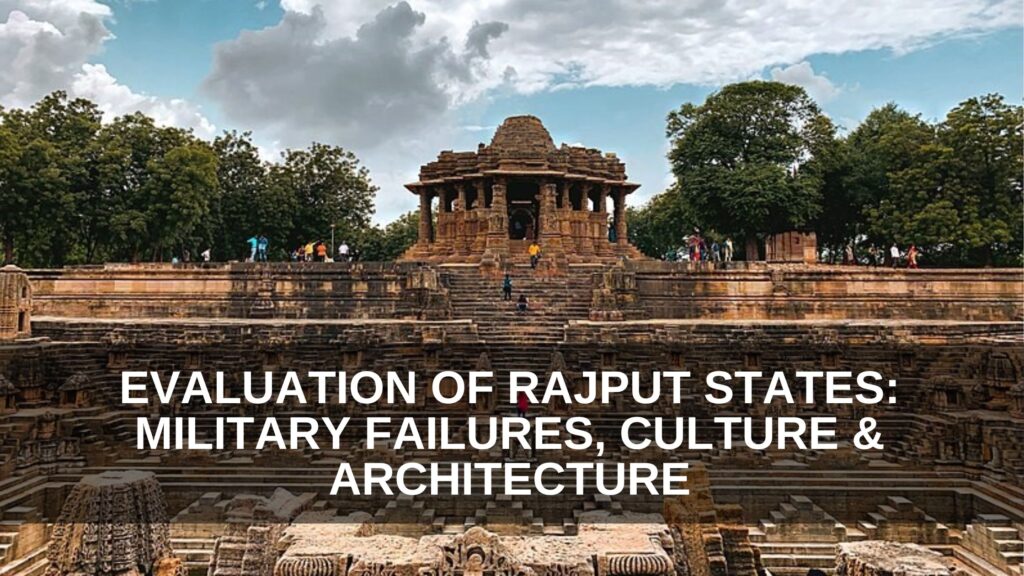The Evaluation of Rajput states played a significant role in medieval Indian history, particularly during the early Muslim invasions. This article explores the reasons behind their military failures, their societal structures, cultural advancements, and contributions to architecture, literature, and economy.
Reasons for the Evaluation of Rajput States
Military Factors:
- Supply of Horses: Cavalry was the backbone of medieval warfare. The Ghurids had a steady supply of superior Central Asian and Arabian horses, whereas the Rajputs faced a restricted supply chain.
- Lack of Mobility: Rajputs heavily relied on elephants, which, while formidable in defense, lacked agility and speed to chase or maneuver against retreating enemies.
- Superior Technology: The Turks enhanced their cavalry with iron stirrups, ensuring stability for riders, and iron horse-shoes, which improved speed.
- Battle Strategies: The Turks employed reserve forces to break enemy lines during exhaustion, whereas Rajputs relied on all-out attacks, often leading to strategic disadvantages.
Download notes of The Great Rajput Dynasty: History, Rulers
Political Factors:
- Feudal System of Governance: Internal power struggles weakened the Rajput kings, making them vulnerable to external threats.
- Lack of Strategic Consciousness: Rajputs underestimated threats from Central Asia and failed to fortify India’s northwestern frontiers.
- Lack of Alliances: Apart from King Bhoja’s efforts against the Ghaznavids, Rajputs often remained divided, prioritizing internal rivalries over collective defense.
Socio-Cultural Factors:
- Poor Discipline: The Rajput military lacked centralized discipline, unlike the well-structured and religiously motivated Ghurid armies.
- Idealistic Outlook: Rajputs adhered to the concept of Dharma Yuddha (righteous warfare), expecting battles to halt at night and refusing to harm surrendered enemies.
- Taking Families to War: Wars were sometimes treated as grand expeditions or sporting events, with Rajput warriors taking their families along, further weakening their military effectiveness.

Various Aspects of Rajput Culture
Social Structure:
Rajput society was clan-based, emphasizing family honor (maan) and loyalty. However, this exclusivity led to rigid social divisions, preventing them from integrating non-Rajputs into their ruling systems.
Religion:
- Most Rajput rulers were devout Hindus and ardent patrons of temples and Brahmins.
- Some Rajput rulers, such as those of Gujarat, supported Jainism.
- They positioned themselves as defenders of the Varna system and upheld Brahminical privileges.
Economy:
- From the 8th century onwards, numerous small towns evolved into vibrant trade centers.
- Markets: Mandapikas (mandis) and Hattas (haats) facilitated local commerce.
- Currency & Barter: The barter system coexisted with currency-based transactions.
Numismatics (Study of Coins):
- Rajput coins bore the image of the ruling king with inscriptions in Nagari script.
- Goddess Lakshmi featured prominently on Rajput coins, a trend that was later imitated by even Muslim rulers like Muhammad Ghori, who issued coins featuring Hindu deities to gain legitimacy among local populations.
Rajput Architecture
Rajput Temples and Architectural Styles:
The Rajput era saw a significant evolution in temple construction, with distinct regional styles emerging:
- Nagara Style:
- Prominent in North India, with Mathura, Banaras, and Dilwara as key centers.
- Panchayatan Style (Chandella Influence):
- Features a central shrine surrounded by four subsidiary shrines.
- Notable Examples:
- Khajuraho Temples (Parsvanatha, Visvanatha, Kandariya Mahadeva) known for intricate erotic sculptures.
- Maru-Gurjara (Solanki) Style:
- Characterized by elaborate carvings on temple walls and ceilings.
- Notable Example: Vimal Vasahi and Luna Vasahi Jain temples at Mount Abu, built under Minister Vastupala.
- Kalinga Style (Odisha Influence):
- Distinguished by its vertical Shikhara with a sudden inward curve at the top.
- Notable Examples:
- Lingaraja Temple (11th century), Konark Sun Temple (13th century), Jagannatha Temple, Puri.
Sculptural Art:
- Rajput sculptures are an extension of classical temple art, featuring elaborate reliefs and dynamic Tribhanga postures.
- Notable examples include the Chandella-era celestial dancer and the Kalachuri-era Dancing Ganesha.
Rajput Literature
Growth of Sanskrit & Regional Languages:
- Cities like Ujjain and Dhara under the Paramaras were major centers of Sanskrit learning.
- Jain scholars made notable contributions to Prakrit and Apabhramsha.
- The foundations of modern Hindi, Bengali, and Marathi were laid during this period.
- Kashmir emerged as a hub of Sanskrit scholarship under rulers like Jaisimha (Lohar dynasty), who patronized poets and historians.
Notable Literary Figures:
- Kalhana: Authored Rajtarangini, chronicling the history of Kashmir.
- Bilhana: Wrote Vikramankacharita in honor of Chalukya King Vikramaditya VI.
- Mankha: Served as the court poet of Jaisimha.
- Jayanaka: Wrote Prithviraj Vijaya, an account of Prithviraj Chauhan.
Download notes of Tripartite Struggle
Rajput Prashastis (Eulogies):
- Prashastis were inscriptions glorifying kings, often exaggerating their achievements.
- Example: Chand Bardai’s Prithviraj Raso claims Prithviraj Chauhan killed Muhammad Ghori while blindfolded, despite historical evidence suggesting Ghori ruled for another decade.
By the end of the 12th century, Rajput states had weakened significantly, paving the way for the rise of the Delhi Sultanate. However, the Rajput legacy endured in their cultural and architectural contributions.
While North India transitioned to Islamic rule, South India continued to be ruled by prominent regional dynasties, which we shall explore in future discussions.


